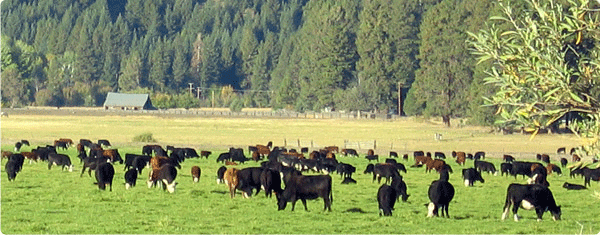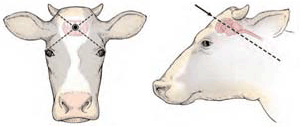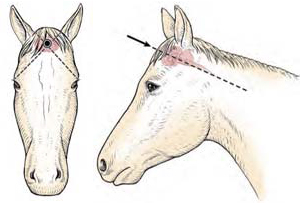
Cattle & Horse Euthanasia Guidelines
Bureau of Livestock Identification
Euthanasia Guidelines for Cattle
Introduction
Severe illness and accidents involving livestock may happen at any time which may require the animal to be humanely destroyed including injuries in transit; severe injuries or illness on the farm; natural, man-made disasters (flood/fires) and road accidents.
It is always best to seek assistance from a veterinarian when considering euthanasia. However, in some circumstances a veterinarian may not be readily available to assist in the evaluation and euthanasia of an animal. The aim of emergency euthanasia is to provide a quick and humane death to prevent or minimize suffering. Emergency euthanasia should be performed when there is an unacceptable delay in treating the animal that would perpetuate or significantly aggravate the condition. If you are in doubt about whether euthanasia is necessary, you should contact a licensed veterinarian.
The 2013 Report of the American Veterinary Medical Association Panel on Euthanasia classifies barbiturate (injectable) euthanasia of ruminants as acceptable, and gunshot and penetrating captive bolts as conditionally acceptable. Only veterinarians have access to barbiturates. Penetrating captive bolt and gunshot are the two best options for emergency euthanasia available to non-veterinarians. Regardless of the method chosen, human and animal safety, logistics and verification of death are critical considerations.
Indications for Emergency Euthanasia for Cattle:
- violent or self destructive thrashing (is the animal a hazard to itself or others?)
- evidence of severe shock (animal is non-responsive to stimuli)
- abdominal contents or organs exposed
- open fracture of a long bone (leg bone below the shoulder or hip)
- animals with chronic and incurable conditions
Calves and bulls require special consideration in selecting the proper method of euthanasia.
Euthanasia by Gunshot:
This should only be performed by individuals well trained in firearm use and safety, with an understanding of ricochet potential. Care must be taken to minimize danger to the operator, bystanders, and/or other animals.
Advantages of a firearm are that it leads to instantaneous death, is inexpensive, and does not require physical contact with the animal.
Death is caused by the direct destruction of the brain, inducing immediate unconsciousness, and permanent destruction of the cardiac and respiratory centers of the brain. Death should be confirmed within five minutes.
Many cities have laws prohibiting the discharge of a firearm within city limits. Be aware of local laws and ordinances.
Firearms:
- Handguns ‐ Calibers ranging from .32 to .45 fired within 1 to 2 feet are recommended for euthanasia of cattle.
- Rifles ‐ Information indicates that .22 Magnum or larger caliber firearms provide higher muzzle energies and more consistent results when delivered to the proper anatomic site.
- Shotguns ‐ Loaded with birdshot or slugs, they are appropriate from a distance of 1 to 2 yards. Preferred gauges are 20, 16, 12 with number six or larger birdshot or slugs are the best choices for euthanizing cattle.
Ammunition:
Solid-point lead bullets are preferable to hollow-point bullets because they are more likely to traverse the skull.
Placement and Aim:

Diagram shows the anatomic site for gunshot or placement of a captive bolt and desired path of the projectile in cattle. The point of entry of the projectile should be at the intersection of two imaginary lines, each drawn from the outside corner of the eye to the center of the base of the opposite horn, or an equivalent position in polled animals.
Available at: https://vetmed.iastate.edu/vdpam/about/food-supply/dairy/dairy-extension/humane-euthanasia/euthanasia-downloads. (Accessed Jun 24, 2011)
Euthanasia by Captive Bolt:
As with a gunshot, the penetrating captive bolt kills by physical destruction of the brain. A penetrating captive bolt gun can be used for euthanasia but must not be used as the sole method and must be followed with a secondary method such as exsanguination.
Placement and aim are the same as for a gunshot, except that the captive bolt gun must be firmly placed perpendicular against the animal's head at the point of impact. Use of this method eliminates the potential for ricochet. Death should be confirmed within five minutes.
The selection of the cartridge strength must be appropriate for the size of the animal; these vary among manufacturers, therefore it is important to follow the specific manufacturers’ recommendations. To ensure maximum concussive power routine cleaning and maintenance should be performed. Inadequate gun care can lead to poor performance requiring more than one shot to kill the animal.
Care and caution should be used when handling a captive bolt gun to ensure human and animal safety.
For information and ordering of a captive bolt gun for emergency euthanasia contact the following manufacturers: Koch Supplies (800) 456-5624, Hantover (800) 821-2227 and Packers Engineering Equipment Co. (800) 279-7326.
Logistics:
When practical, choose a location where the carcass can be easily reached by removal equipment. Remember, livestock should be handled so that no unnecessary pain or suffering is imposed prior to euthanasia.
Confirmation of Death:
Immediately following the shot the animal will collapse and may experience a period of intense muscle contraction (usually no longer than 20 seconds) followed by a period of relaxation and some poorly coordinated kicking or paddling movements. Absence of rhythmic breathing, heartbeat, and corneal reflex (a blink) confirm death. Touch the cornea to ensure no corneal reflex. The presence of any eye movement or blinking, at this point, should be viewed as evidence of sustained or recovering brain activity and should be dealt with by a repeat shot.
Developed by the State of California, Department of Food and Agriculture, Animal Health and Food Safety Services, Animal Health Branch 1220 N Street, Sacramento, CA 95814 Office: (916) 900-5002 or visit our website at www.cdfa.ca.gov/ahfss/animal_health/.
Disclaimer: CDFA does not intend the release of these guidelines to affect the legal issue of criminal responsibility in any way.
Emergency Euthanasia Guidelines for Equines
Introduction
Severe illness and accidents involving horses may happen at any time. Some situations such as trailer accidents, road accidents, natural or man-made disasters (flood/fires), catastrophic injury during competition, or on farm disease outbreak or injury resulting in severe injury or illness of the animal may require humane euthanasia. It is always best to seek assistance from a veterinarian when considering euthanasia. However, in some circumstances a veterinarian may not be readily available to assist in the evaluation and euthanasia of an animal. The welfare of the horse in these circumstances may require emergency euthanasia. The aim of emergency euthanasia is to provide a quick and humane death to prevent or minimize suffering.
Emergency euthanasia should be performed when a delay in treating the animal would perpetuate or significantly aggravate the condition. If in doubt about the necessity of euthanasia immediately contact a licensed veterinarian. The 2013 Report of the American Veterinary Medical Association Panel on Euthanasia classifies barbiturate (injectable) euthanasia of equids as acceptable, and gunshot and penetrating captive bolts as conditionally acceptable. Only veterinarians have access and are licensed to use barbiturates. Penetrating captive bolt and gunshot are the only acceptable options for emergency euthanasia by non-veterinarians. Regardless of the method chosen, human and animal safety, logistics and verification of death are critical considerations.
Indications for Emergency Euthanasia for Horses:
- Violent or self-destructive thrashing causing the animal to be a hazard to itself or others
- Evidence of severe shock such as an animal that is non-responsive to stimuli
- Exposure of abdominal contents or organs
- Open fracture of a long bone which includes the leg bones below the shoulder or hip
- Animals with chronic and/or incurable conditions as evidenced by an animal demonstrating signs of severe pain and distress
Euthanasia by Gunshot:
Gunshot euthanasia should only be attempted by individuals well trained in firearm use and safety, and those who have an understanding of ricochet potential. Extreme care must be taken to minimize danger to the operator, bystanders, and/or other animals.
Firearm euthanasia leads to instantaneous death due to the direct destruction of the brain, resulting in immediate unconsciousness and permanent destruction of the cardiac and respiratory centers of the brain. Death should be confirmed within five minutes.

Placement and Aim: The diagram shows the anatomic site for gunshot or placement of a captive bolt and desired path of the projectile in equids. The point of entry of the projectile should be at the intersection of two imaginary lines, each drawn from the outside corner of the eye to the center of the base of the opposite ear.
Many cities have laws prohibiting the discharge of a firearm within city limits. Be aware of local laws and ordinances.
Adapted with permission from Shearer JK, Nicoletti P. Anatomical landmarks. Available at: https://vetmed.iastate.edu/vdpam/about/food-supply/dairy/dairy-extension/humane-euthanasia/euthanasia-downloads
Euthanasia by Captive Bolt:
The penetrating captive bolt euthanizes by physical destruction of the brain. Only a penetrating captive bolt gun can be used for euthanasia. A concussive captive bolt gun should never be used as it is not an effective means of euthanasia for horses. Placement and aim of the captive bolt is the same as described for a gunshot, except that the captive bolt gun must be firmly placed perpendicular against the animal's head at the point of impact. Use of this method eliminates the potential for ricochet. Death should be confirmed within five minutes.
The selection of the cartridge strength must be appropriate for the size of the animal. As strength varies among manufacturers, it is important to follow the specific manufacturers' recommendations. To ensure maximum concussive power routine cleaning and maintenance should be performed. Inadequate gun care can lead to poor performance requiring more than one shot to kill the animal.
Care and caution should be used when handling a captive bolt gun to ensure human and animal safety.
For information and ordering of a captive bolt gun for emergency euthanasia contact the following manufacturers: Koch Supplies (800) 456-5624, Hantover (800) 821-2227 and Packers Engineering Equipment Co. (800) 279-7326.
Logistics:
Whenever practical, choose an euthanasia location that is easily accessible for carcass removal equipment. Remember, horses should be handled so that no unnecessary pain or suffering is imposed prior to euthanasia.
Confirmation of Death:
Immediately following the gunshot or captive bolt euthanasia the animal will collapse and may experience a period of intense muscle contraction (usually no longer than 20 seconds) followed by a period of relaxation and some poorly coordinated kicking or paddling movements.
Absence of rhythmic breathing, heartbeat, and corneal reflex (a blink) confirms death. Touch the cornea to ensure no corneal reflex. The presence of any eye movement or blinking, at this point, should be viewed as evidence of sustained or recovering brain activity and should be dealt with by a repeat shot.
Developed by the State of California, Department of Food and Agriculture, Animal Health and Food Safety Services, Animal Health Branch 1220 N Street, Sacramento, CA 95814 (916) 900-5002 or visit our website at www.cdfa.ca.gov/ahfss/animal_health/.
Disclaimer: CDFA does not intend the release of these guidelines to affect the legal issue of criminal responsibility in any way.

